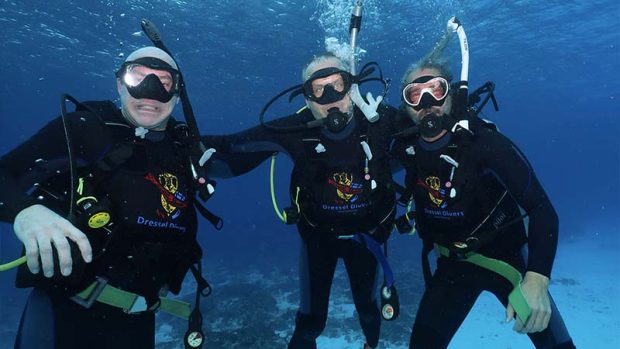Scuba diving suits are protective gear that keep people safe within the water. The primary function of these suits is to maintain body heat. Water can be a lot colder than air temperature. As such, diving suits have insulation properties that allow people to stay warm on their dive.
There are three types of diving suits:
- Wetsuit
- Dry suit
- Semi-dry suit
As you can imagine, dry suits keep the person scuba diving completely dry from the water despite immersing themselves. Wetsuits protect the diver from cold temperatures but allow water to flow through the gear. Semi-dry suits are a combination of both. All have quick-drying power so that you can avoid sitting in a wet suit on land.
Diving suits are an incredible tool for swimming and exploring. However, do you ever wonder how they are made, and how their production influences the way they work?
Continue reading to answer all your questions about scuba diving suits!

How Manufacturers Make Scuba Diving Suits
Manufacturers make wetsuits and dry suits very similarly. They are both constructed in a factory using an assembly line.
The main ingredient of dive suits packages is neoprene. This rubber-like material arrives at the factory as a liquid. Manufacturers add other materials to the liquid neoprene, then bake the mixture in an oven.
Once the rubber cools, it travels through a machine that slices it to the desired thickness. Divers have the choice of several thickness levels for their package. They range between 7 millimeters (mm) and 5 mm to 3 mm and 2 mm. Resultingly, the machine adjusts according to the number of mm being produced.
The neoprene rubber material appears as sheets. They follow the conveyor belt to the step where manufacturers apply a nylon covering. This layer makes the rubber stretchy, allowing more flexibility for the future diver.
After this step, the materials head to the people who assemble the dive suits. They stack the rubber sheets and draw an outline on the top layer. A machine cuts along the lines. In contrast, dry suits are cut by hand.
The manufacturer then sends the products to sellers so they can be used for the next diving excursion.
The Purpose (and Advantages) of Wearing Scuba Diving Suits
There are so many reasons to have a diving suit. In some cases, they are strongly recommended, as cold water can be gravely dangerous. It is helpful to have a complete dry suit or wetsuit package for ultimate protection.
Nevertheless, here are the primary purposes of wearing diving suits:
Insulation
A dive suit should be well insulated. This is its primary goal, as divers can become severely sick with hypothermia due to low temperatures. Neoprene does an excellent job of retaining body heat and blocking the cold.
Additionally, the tighter fit of a dive suit prevents cool temperatures from entering it in the first place. Both wetsuits and dry suits try to keep the water out, which can make them colder.
Protection
Besides insulation from the cold layer of water, a diving suit protects the diver from other dangers. Some of these include fish and wildlife, rocky surfaces, and even the sun that causes sunburn.
As a result, a diving suit does a lot more than keep you warm. It is a general protector from all the hazards that your body would be exposed to. Divers can acquire better protection with a dry suit or wetsuit package, which includes extra gear, such as gloves and boots, to cover what the suit cannot.
What Comes in a Diving Wetsuit Package
Many experienced divers recommend purchasing a complete dive suit package. This is more than just the suit itself. It also includes boots, gloves, and a hood to cover the head and ears. These diving packages come in many shapes, sizes, and thickness levels.
When shopping for the right diving suit package, it is critical to remember that the thickness of the dive suit is not going to be identical to the additional diving gear. Let’s consider this: if you purchase a 5 mm suit, you should acquire 3 mm gloves. This difference is crucial because it allows more mobility to your hands, a necessary ability during a dive.
Boots are different from gloves. The sizing is similar to the measurements used to size your foot. As such, you should search for diving boots according to your shoe size.
The Difference Between Wetsuit Packages and Dry Suit Packages
Dive suit packages come in all shapes and sizes. There are several types of wetsuits, such as:
- Full body
- Shorty
- Farmer John/Jane
These gear styles adjust to every diver’s body through different sizes and unique thickness levels. Nevertheless, dive suits can be a wetsuit or a dry suit. You should select the variation that works best for the activity you plan to complete.
The main difference between the two diving suits is how much water they allow inside. A wetsuit package can be worn in milder water temperatures, as they allow the flow of water. It still insulates body heat, but the diver feels more connected to their environment.
A dry suit package does not allow water to enter the suit. Consequently, they are not as warm, so people who wear them should have proper undergarments that help preserve heat. What’s more, the price of these dive suits and their respective packages are higher than a standard wetsuit.
How to Find the Right Suit for Your Dive
Finding the best diving suit depends on the water temperature that you plan to submerge yourself in. Environments with warmer water—above 80 degrees Fahrenheit—would only need a short sleeve dive suit.
On the other hand, cooler temperatures in the 50s or 60s would require a full-body diving suit. A dry suit is necessary for waters below freezing.
You should be aware of the price ranges for the dive suits too. If you are a regular diver, high quality should be your go-to. Occasional divers should opt for a modest budget but still prioritize the effectiveness of the suit for their dive.
The Bottom Line
If you go into a store that sells diving suits and diving packages, the clerks and salespeople can help you find the right fit for your dive. They can also walk you through the steps of how the dive suit was made. You can get more information about the journey your suit has taken to be in your hands.



